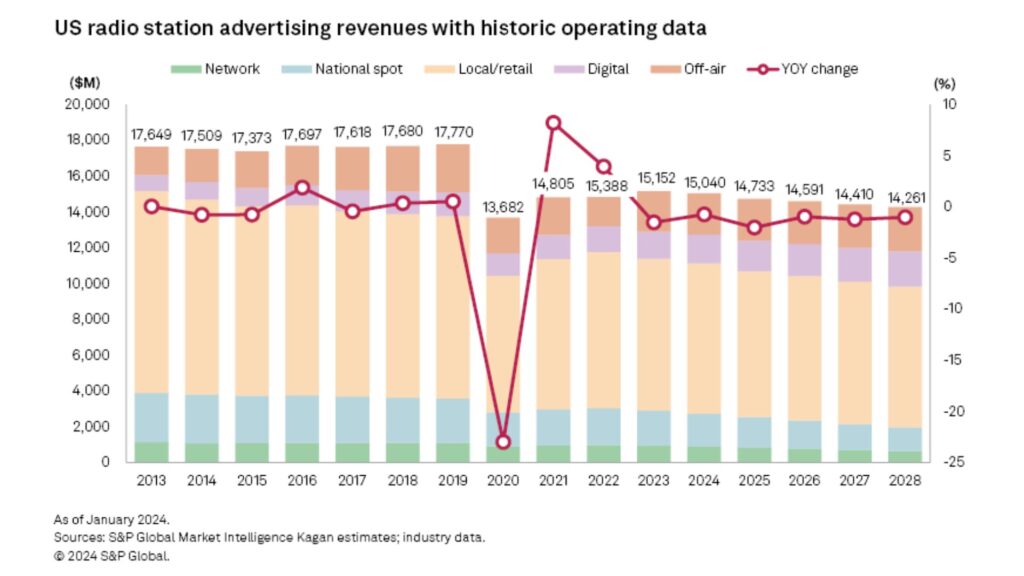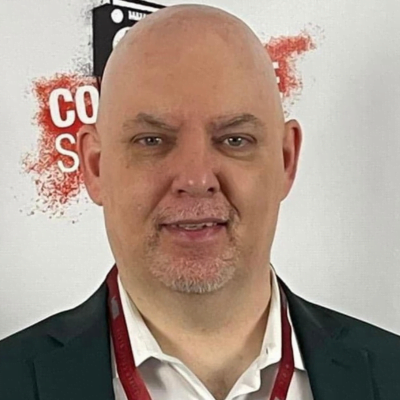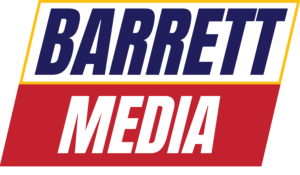I attended and spoke at the Louisiana Broadcasters Association Annual Convention last week. My focus was on the economic state of the radio business, and the importance for brands to have multiple revenue strategies beyond the radio ad model. I’m still a huge advocate for the radio business and know that the majority of revenue comes from traditional advertising. The lack of growth though is frustrating, and too many working across the country are quick to reject new ways forward.
Whether you go by the S&P Global Market, Radio Advertising Bureau, BIA Advisory Services, Borrell and Associates or another group, the story is similar. Radio has been flat to down for over a decade. Television revenues are declining too, with streaming expected to pass TV for the first time ever this year. The IAB also reported in April that digital video advertising spending is growing 80% faster than media overall.
These stories are shared year after year, and it leads me to wonder ‘how is the radio business going to grow if it doesn’t expand its horizons?’ Executives in radio groups are asking these same questions. If you wonder why layoffs keep occurring, it’s because costs are rising, and business growth isn’t. Eventually, you need more revenue to support additional staff and investments. If it’s not there, adjustments have to be made.
In 2023, radio industry revenue topped 15 billion dollars. That’s a respectable number except it’s not much different from what’s been reported annually every year since 2013 minus the pandemic year (2020). In fact, go back 10-15 years and you’ll find the industry was generating two to three billion dollars more each year.
During the past decade though, rent, gas, food, cars, and employee wages have increased. In New York alone where I’m based, minimum wage doubled from $8 per hour in 2013 to $16 in 2024. The level of media competition and the platforms showcasing content have also soared. This is why brands have to be active in business beyond radio if they hope to grow.
I’ve talked about the need to be aggressive in the merchandise space before. It’s been ignored. Yet groups like the WWE, which has seven hours of weekly television programming generates over a hundred million dollars annually in merchandise revenue. I get that the WWE is a global brand, so I’m not naive to think radio can be anywhere near that level. It can’t. But radio has the same access to websites and social media platforms, and 168 hours of programming each week. Are we using our tools the right way and leaning into the opportunity?
Barstool Sports is another great example. They generated thirty million dollars in merchandise revenue between December 2020 and November 2021. The brand has podcasts, social media, and websites just like your radio or TV outlet. They were also on SiriusXM for years, but social media and the web drive their sales. The brand was so on top of its merchandise strategy that it even monetized Mike Francesa better than WFAN did years ago. The difference, moving product is a mindset for Barstool. Radio unfortunately doesn’t think and operate that way.
If a top-20 market brand can’t make six figures annually selling its own products, then the internal execution and strategy is wrong. I’d even go as far as saying the wrong people are likely spearheading it. If you feature personalities that matter to local fans and believe in your airwaves enough to convince advertisers to spend six figures on them to grow sales, then you should be doing the same with your own products.

But it’s not just about merchandise. What’s your live events strategy? Are you doing two to four big revenue generating shows per year? I’m not talking about live remotes at car dealers or restaurants. I’m referring to the equivalent of a concert in your town. Would your audience spend $50-$150 per ticket to attend a function your brand created? To do that, you have to create killer ideas, involve important people, and deliver a memorable experience. Your on-air and social promotion is a key driver of it.
If you’re not producing big dollars from live events, maybe it’s time to review your creative ideas, ticket pricing, venue expenses, branded advertising opportunities inside the event, etc.. What are you creating that’d get the market buzzing? For example, ESPN, Fox Sports and Warner Brothers found a way to create a streaming service together. Could you and your competitor join forces on a co-branded ticketed event? If you brought two notable brands and staffs together for a killer event, and sold tickets, in-event advertising, YouTube/Podcast sponsorships, and co-branded merchandise, I’m sure your listeners would open their wallets.
Podcasting is another area that continues to grow with listeners. On the local level though, monetizing it remains a challenge. Does that mean it’s not worth selling? No. But if you’re limited in your earning potential with the way you currently sell, maybe it’s worth approaching it differently.
Good Karma Brands in Cleveland created a subscription model years ago designed to earn from its audience. Many questioned the approach, but GKB unlocked six figure earnings doing it. Radio is always quick to promote the power of free, and that’s great, but there are brands like The Guardian, The Information, The Free Press, and New York Times who are growing thanks to fans investing in them. Should we be doing it too in spaces we’re less confident monetizing?
I can make a case for many opportunities, but the reality is that you have to care enough about being stagnant to want to do something about it. Cameo is a video service that many of your talent are on and make little revenue from because they don’t promote it. Yet celebrities, musicians, wrestlers, etc. earn strong revenues on it. Is it worth creating a revenue sharing model between talent and brand to help both parties benefit? If you make zero now, what are you losing?
Lastly, do you know how much it costs in 2024 to go to college for four years at a major university? It’s roughly 25K to 75K per year with on campus living included depending on the school and state. Trade schools also profit off of education by charging 7K to 15K per course per attendee.

When those students finish, what do they want? A job in your industry. The instruction they gain at school is good but it’s not as advanced as what they’d receive in a radio/TV operation. Yet brands make nothing (unless the school buys an ad schedule) on education even though they have the best assets to work with.
Most brands employ a programmer, seller(s), imaging director, head of digital, radio talent, producer(s), play by play talent, personalities with TV, writing, and podcasting experience, and have relationships with local teams, athletes, and venues. They also have the one thing most coveted by those paying for an education – a job. If a successful, local brand created a 12-16 week course utilizing the best in the business inside their building, and gave away one FT job and a few PT jobs at the end of it, do you think it’d generate interest? Of course it would. If 25 students signed up at 5K-10K per person, that’s 125K-250K. Do I have your attention now?
I know that selling radio ads is your first priority. I’m not suggesting it shouldn’t be. But you will not grow your business if you aren’t exploring new ways to generate revenue. Maybe it’s events, merchandise, Cameo, podcasting subscriptions or broadcaster training courses. Maybe none of those work but you’re bullish on renting your studio space, creating branded content on social platforms for clients or selling SEO services or AI training. Radio is a good business and the foundation of your brand, but unlocking your full revenue potential requires exploring and mastering new spaces.
______________________________________________________________________________________________________
Hello Digital, Bye Bye Radio:
The Horn in Austin, Texas is shifting to a digital only product. New owners, Norsan Media believe the Austin sports brand and country station KOKE will reach a broader, more diverse audience, allowing the company to adapt to a rapidly changing media landscape. The changes go into effect on June 1st.
Good Karma Brands previously announced plans to prioritize its app in New York City for its shows on 98.7 ESPN NY. The one difference, GKB also has an AM signal, 1050AM. The Horn won’t have that luxury, which raises the question, will more of these situations pop up? How are brands going to make up for being less visible inside the vehicle? Will advertisers and play-by-play partners support or reject those who have a minimal or non-existent radio presence?
There’s more to be learned but this should be an interesting trend to follow in the years ahead.
______________________________________________________________________________________________________
Thumbs Up
Jim Rome: The first impression on X of Rome’s video simulcast of his radio program was strong. I watched some of it while flying to New Orleans and thought the presentation was visually on point. Judging by the response shared by Linda Yaccarino, moving from TV to X could be exactly what Rome and his team needed to shake things up.
RTDNA: 41.4% of radio news directors and general managers say they’re seeing more evidence of burnout this year. Major markets (58.5%) and larger newsrooms (62.9%) face the biggest challenges. Numbers are even higher among television professionals. The survey included responses from as many as 1,387 television stations (73.9%) and 631 radio news directors and general managers representing 1,902 radio stations.
Though I love to work, and think there are differences between young people entering the industry now and when I started, it’s good to see RTDNA raising awareness to these issues. Broadcasters get worn out when asked to absorb too many duties. I understand the challenge of keeping expenses down, but if not having support leads to your best people leaving, is that worth it?
Colin Cowherd: I had a chance to listen to Colin’s conversation with Erika Ayers Badan over the weekend. It was really good. Folks who enjoy business discussions, take a listen. When Colin uses his podcast to discuss business with accomplished people, it’s always informative.
______________________________________________________________________________________________________
Thumbs Down:
Keith Hernandez: Keith must’ve skipped mathematics class because a simple equation such as 17 + 8 shouldn’t be difficult. Judging from the response to the Mets broadcaster’s blunder, Hernandez might want to leave the math problems to Gary Cohen and Ron Darling.
Radio Haters: If you’re connected to a lot of people and log on to social media each week, you’re eventually going to find someone who previously worked in the industry and enjoys complaining about it. Is the business perfect? No. Does it have problems? Of course. But it’s still pretty damn good and important to millions of people. I left day-to-day radio life almost 9 years, and still find plenty to be excited about. If you want to suck the life and fun out of social media by pissing and moaning about how much better the business was during your glory days, knock yourself out. I’d prefer to live in the present, and embrace what lies ahead.
______________________________________________________________________________________________________

Jason Barrett is the President and Founder of Barrett Media since the company was created in September 2015. Prior to its arrival, JB served as a sports radio programmer, launching brands such as 95.7 The Game in San Francisco, and 101 ESPN in St. Louis. He also spent time programming SportsTalk 950 in Philadelphia, 590 The Fan KFNS in St. Louis, and ESPN 1340/1390 in Poughkeepsie, NY. Jason also worked on-air and behind the scenes in local radio at 101.5 WPDH, WTBQ 1110AM, and WPYX 106.5. He also spent two years on the national stage, producing radio shows for ESPN Radio in Bristol, CT. Among them included the Dan Patrick Show, and GameNight.
You can find JB on Twitter @SportsRadioPD. He’s also reachable by email at Jason@BarrettMedia.com.








